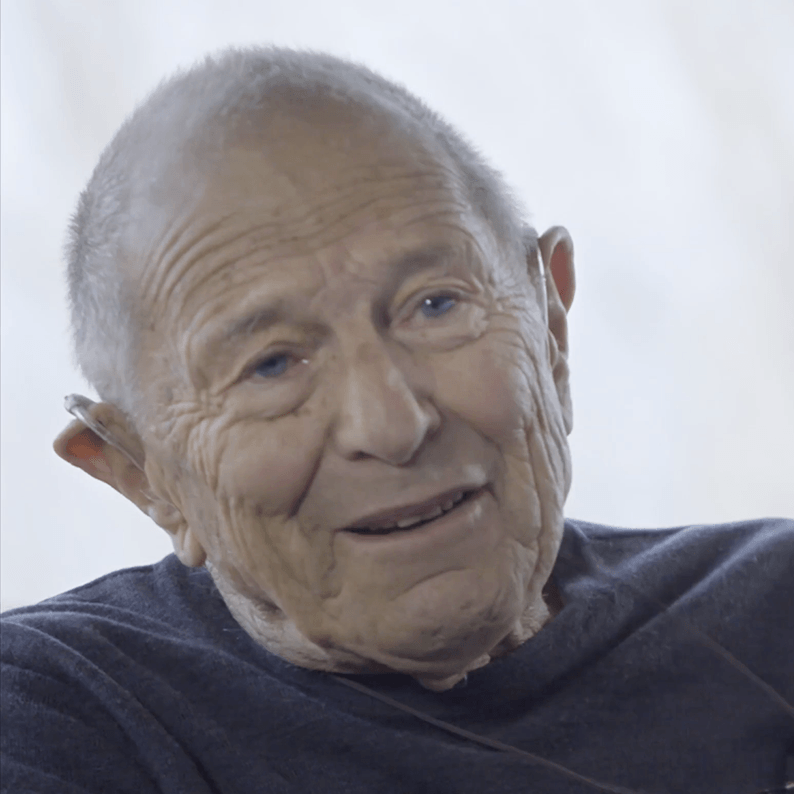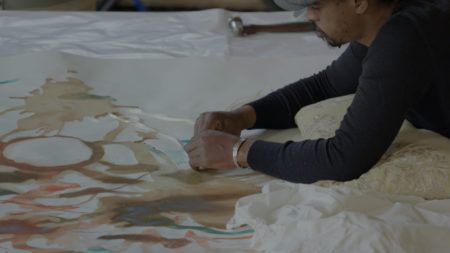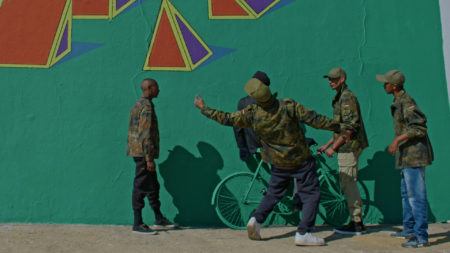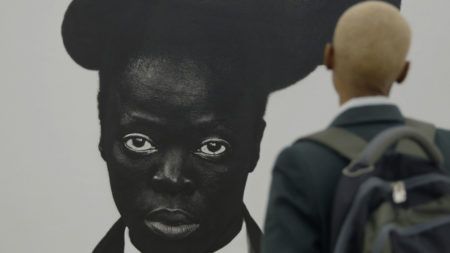Continue playing
(Time remaining: )
Play from beginning
Continue playing "{{ controller.videos[controller.getVideo(controller.currentVideo)].segmentParentTitle}}"
{{controller.videos[controller.getVideo(controller.currentVideo)].title}} has ended.
David Goldblatt in "Johannesburg"
Considered the dean of South African photography, David Goldblatt’s near-six-decade-long career chronicled and critiqued the country’s tumultuous modern history. Interspersed with scenes of Goldblatt touring the sites of past and current photographs, this segment surveys the artist’s extensive body of work; his earliest projects captured the desperate lives of African gold miners and critically probed white Afrikaner privilege and his more recent series examined the country’s changing politics through the evolution of its architectural structures. Goldblatt’s work is a testament to the power of photography as a means of social criticism. This segment was filmed and edited in the months prior to Goldblatt’s passing in June 2018.
Credits
Executive Producer: Tina Kukielski. Series Producer: Nick Ravich. Director & Producer: Ian Forster. Editor: Morgan Riles. Director of Photography: Motheo Moeng (SASC).
Field Producer: Jason Hoff & Thuli Lote. Production Coordinator: Ife Adelona. Curatorial Assistant: Danielle Brock.
Title Sequence & Typography: Afternoon Inc. Composer: Joel Pickard. Narration: Carrie Mae Weems. Additional Photography: Jarred Alterman, Dominic Egan, Natalie Haarhof, Marco King, Lawrence Marais, John Marton, Jabulani Mdlalose, Larry Rochefort, Rafael Salazar, Katlego Shibambo, & Fredrik Streiffert. Assistant Camera: Pierre-Henri Debies, Aurélie Gélibert, Culize Heyns, Ben Marcus, Nkateko Ngomane, Matome Thomo, & Loveson Xaba. Sound: Warren Frense, Chris Mayer-Hohdahl, Nathan Medcalf, Austin Plocher, Ruan van Tonder, & Ava Wiland. Production Assistant & Driver: Sebastian Bailey, Adam Dietrich, Mike Phokontsi, & Sunny Sekopane. Security: Clinton Merber & Paul Nel.
Digital Intermediate: Blue Table Post. Post-Production Producer: Oliver Lief. Colorist: Natacha Ikoli. Re-Recording Mixer & Dialogue Editor: Rich Cutler. Additional Animation: Andy Cahill. Assistant Editor: Caroline Berler, Adam Boese, Maya Elany, & Jonah Greenstein. Technical Evaluation: Pillar To Post. Translation: Bangula Lingo Centre.
Artwork Courtesy: David Goldblatt, Nicholas Hlobo, Zanele Muholi, Robin Rhode, Goodman Gallery, Lehmann Maupin Gallery, Marian Goodman Gallery, Stevenson Gallery, & Yancey Richardson. Archival Materials: ArtReview; Paula Court; “Goldblatt” by Daniel Zimbler, Courtesy of Goodman Gallery; Inkanyiso; Institute of Contemporary Art, Boston; John Kennard; Library of Congress, Geography and Map Division; New Tradition; Performa; Pond5; & Paul Weinberg. Additional Music: Yesway.
Additional Art21 Staff: Maggie Albert, Lindsey Davis, Lolita Fierro, Joe Fusaro, & Jonathan Munar. Interns: Diane Huerta, Esther Knuth, Sunny Leerasanthanah, & Kristopher Neira. Public Relations: Sutton. Station Relations: De Shields Associates, Inc. Legal Counsel: Barbara T. Hoffman, Esq.
Hlobo Assistants & Performers: Michael Borden, Theko Boshomane, Troizel Carr, Alexander Diaz, Carlos Florentino, Matthew Frazier, Garrett Gray, John-Deric Mitchell, Lerato Motaung, Ashton Muñiz, Tshepo Phokojoe, Mike Thipa, Amei Wallach, Isaac Zavale, & Sthembiso Zwane. Muholi Participants: Bathini Dambuza, Roxy Dlamini, Lerato Dumse, Katiso Kgope, Vuyelwa “Vuvu” Makubetse, Ayanda Masina, Yaya Mavundla, Mellisa Mbambo, Miss Tee Menu, Collen Mfazwe, Odidi “Odidiva” Mfenyana, Xoliswa Mgqumeni, Kim Monoto, Phahlane Mpolokeng, Kofi Osei, Monoe Phahlane, Progress Seloate, Katlego Serame, Carla Sibanyoni, Busi Sigasa, Dimpho Divine Tsotetsi, & Vllender. Rhode Assistants & Performers: Ivor Bezuidenhout, Keenan Bezuidenhout, Kevin Bezuidenhout, Randy Bezuidenhout, Keano Essop, Muhammed Yaseen Hendricks, Andries Kumbme, Joshua LeGrange, Ashwin Lewis, Armando Makama, Kevin Narain, Wesley Rhode, Byron Sampson, Maxime Scheepers, Seuntjie Tebogo, Tebogo Jerry Tshabile, & Donovan Yaards.
Special Thanks: The Art21 Board of Trustees, Noreen Ahmad, Federica Angelucci, Sébastien Bizet, Joost Bosland, Centre Pompidou, Sinazo Chiya, Rebekah Chozick, Jessie Cohen, Liza Essers, Foire Internationale d’Art Contemporain, Fondation Louis Vuitton, The French Institute of South Africa, Damon Garstang, Roselee Goldberg, Lily Goldblatt, Maaike Gouwenberg, Benjamin Ambrosius Heinz, Deslynne Hill, Joburg Art Fair, Bob Kalas, William Kentridge, Karolina Lewandowska, Market Photo Workshop, Nthabiseng Mokoena, Marta de Movellan, Etienne Naude, Sisipho Ngodwana, Esa Nickle, Performa, Job Piston, Pollack’s Bottle Store, Pulp Films, Jean-François Quemin, Zakara Raitt, Sara Roffino, Angéline Scherf, Nicole Siegenthaler, Hank Willis Thomas, Uppsala Art Museum, & Elodie Vincent.
Series Created By: Susan Dowling & Susan Sollins.
Dedicated to David Goldblatt.
Major support for Season 9 is provided by National Endowment for the Arts, PBS, Lambent Foundation, Agnes Gund, Ford Foundation, The Andy Warhol Foundation for the Visual Arts, The Anna-Maria and Stephen Kellen Foundation, The Horace W. Goldsmith Foundation, Toby Devan Lewis, Nion McEvoy, and The Phyllis C. Wattis Foundation.
Closed captionsAvailable in English, German, Romanian, Italian, Japanese, Korean, Chinese, Italian
Through the Art21 Translation Project, multilingual audiences from around the globe can contribute translations, making Art21 films more accessible worldwide. Translate this video now.
Interested in showing this film in an exhibition or public screening? To license this video please visit Licensing & Reproduction.
David Goldblatt was born in Randfontein, South Africa, in 1930. Since the early 1960s up until his passing in 2018, Goldblatt photographed the people, landscapes, and architectural structures of South Africa, using photography as a means of social criticism. Chronicling South Africa during apartheid, Goldblatt’s powerful monochrome photographs reveal the stark contrast between the lives of Blacks and Whites as well as the ways that public structures have manifested the citizens’ self-image.
“A common response from potential publishers was ‘where’s the apartheid?’ To me, it was embedded deep, deep, deep in the grain of those photographs.”
David Goldblatt




